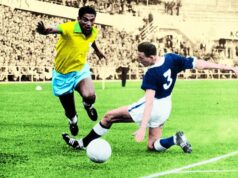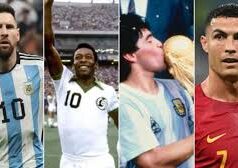Jumpers for goalposts, a ball or sometimes a discarded soda can and let the match begin!
This is how most of soccer players in history started out at a young age, including the very best of them. And this how they developed their sharp technique and creativity on the pitch: by playing with friends in small spaces, everyday and for hours.
No large field, no markings, no corner flags, no referees, not even eleven players per team, but will, passion and dreams. Endless dreams. Those that one day become reality.
Once Johan Cruyff said that soccer players from the street are more important than trained coaches for the development of the sport. And we are talking about kids who literally played soccer on a small street, with a wall, clothing or fence for goalposts and passers-by or vehicles interrupting the match. But, that would not demotivate them from keeping on playing.
Other times those soccer games would take place in a park (sometimes a small one), a school yard or an open space. It gets more interesting. On most occasions there would be made-up teams with the players taking the names of their idols.
The housing estate boys
Zinedine Yazid Zidane‘s journey to the top of the world started in Marseille’s La Castellane, a tough neighborhood with several ethnic backgrounds. Back in 1981. Zidane always pretended to be Uruguayan wizard Enzo Francescoli “on the field” It was the Place Tartare, the main square of a housing estate where generations of boys have played a cramped version of soccer since the 1950s. Zidane would still visit the estate as a Juventus players in the 1990s and give money to the teenagers to run their own independent teams.
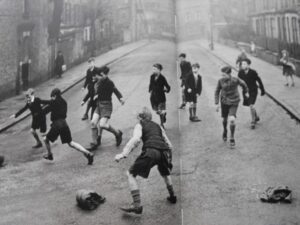
Zlatan Ibrahimovic‘s story is quite similar. He grew up in the Rosengard district of Malmo, in a tough area with other immigrants’ kids. His neighborhood was often referred then as a ”ghetto” with extremely high crime numbers. It was a courtyard within a council estate, where Ibrahimovic started playing soccer during his childhood in late 1980s. It would not take him long to develop his skills and sign for local club Malmo. The rest for Ibrahimovic is history. On 8 October 2007, that courtyard was transformed to a five-a-side soccer pitch under the name ”Zlatan Court”. A reminder where everything started from for one of Sweden’s greatest players ever.
”Here is my heart, here is my history. Here is my game. Take it further”
Reads the inscription at Zlatan Court
From street soccer to the national team!
George Gullit and Herman Rijkaard, close friends and both former soccer players, had travelled to Holland from Suriname. Their famous sons were born to Dutch mothers within a month of each other in September of 1962 and also became close friends growing up in Amsterdam’s Oud-West neighborhood. Ruud Gullit and Frank Rijkaard joined local club DWS in 1973 at the age of 11, while also kicking around playing street soccer in their free time at the Balboaplein square. Fifteen years later those street players would be crowned champions of Europe together when the Nertherlands beat the Soviet Union 2-0, with Gullit scoring the first goal. Their first street soccerfield, Balboaplein, is still in use, hosting small neighborhood tournaments such as the “MaJo” where Moroccan and Jewish teams meet.
The dilemma about the greatest player in the 1930s and 1940s was Giuseppe Meazza or Matthias Sindelaar? The latter, considered the best Austrian of all time grew up in the Favoriten district of Vienna, known for its large Czech-speaking community. Sindelaar was the son of Czech immigrants like Josef Bican and they both learned soccer in the streets of Favoriten. In 1934 they would lead the Austrian national team to the World Cup semifinals where the ”Wunderteam” lost by 1-0 to notoriously favored by the match officials, Italy.
The ”Paper Man” was found dead with his girlfriend in 1939, aged just 35. His outspoken opposition to the Nazi triggered many theories and speculation about the cause of his death, officially stated as an accident. On the other hand, Bican would go on to become the world’s highest goalscorer leaving his mark at Slavia Prague’s history.
Sete de Setembro Club: Pelé’s first team!
Rua Rubens Arruda. The street that Pelé learned to play soccer in the late 1940s. And also the street that his family’s house was located in Bauru. Pele, his younger brother Zocca and their friends who most lived on a nearby street called Rua Sete de Setembro soon formed their first soccer club! It was in 1951 and the name of Pelé’s first team ever was ”Sete de Setembro Club”, winning the majority of its games against other teams.
A year later, the mayor of Bauru announced the launch of a youth soccer tournament, the ”Nicola Avalone Junior Victory Cup”. Sete de Setembro Club changed its name to Amériquinha (Little America) and not only participated in the tournament but won it against all odds. Ameriquinha were coached by Ze Leite, whose three boys were playing in the squad. 12-year old Pelé was the topscorer and the final was held at Bauru Atletico Clube’s ground in front of 5.000 spectators!
In 1953 Amériquinha, run by Pelé and his friends, was dissolved after daily arguments between the players. However, it was not long enough when Bauru AC started a juvenile team asking Pelé and several Amériquinha’s players to register with the club.
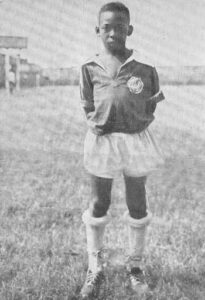
Africa’s famous soccer street players
Eusebio was born just 2 years after the ”King of Soccer” in 1942 and grew up in the Malafala neighborhood, in Lourenco Marques, Mozambique. He used to ditch school to play barefoot soccer with friends on improvised pitches and even using garbage to make a ball. With Mozambique being a Portuguese-speaking country the admiration for the Brazilian national team and its 1950s stars like Ademir and Zizinho was massive among the local soccer fans. Therefore, it was a little surprise when Eusebio and his friends named their team as ”Os Brasileiros” (The Brazilians) and started playing against other neighborhoods.
In 1957, the greatest African player of all time, 15 at the time, joined Sporting Lourenco Marques. Four years later he signed for Portuguese giants Benfica leading them to European Cup glory in 1962.
Another street player was Nwanko Kanu who was born in Owerri, Imo state, East Nigeria. The man who led the ”Super Eagles” to the Olympic gold medal in 1996, grew up playing on the street and more specifically, the Tetlow Street. Himself and the other boys would meet there everyday, put posts down at each end and if a car came someone would call out and they’d have to stop to let it pass. Weekends were the best time, especially Sundays, when everybody would go to church, so the roads were really quiet. And sometimes Kanu and his friends would play matches at a school nearby, on a larger ”field” but with a harder surface. There were all seven or eight years old and continued played street soccer even when they joined the Spartans, the local club where chairman was Kanu’s dad.
Mahamadou Diarra is the only player from Mali who played for Real Madrid. In 1989 he was eight years old when he started kicking a ball and playing games on the street. There were 18 to 20 boys with only one dream: to become professionals. Diarra and his friends would set up their own pitch on the street putting stones down a metre apart to make a goal and play two hours without a break. Sometimes, they’d have to give life to an old ball that had burst by cutting a hole in it and stuff it full with old clothes. Of course those kind of balls were hard and they would not bounce, but they would get the match going.
Diarra often visits Mali and goes back to the street he had his first soccer memories in Bamako. He even meets up with his old friends to play soccer. Fun fact? They would not let him be the captain, even though they know he captained Mali, their national team. It must be those ”street rules” set back in 1989.
I trained 3-4 Hours a week at Ajax when I was little but played 3-4 hours a day on the street. So where do you think I learned soccer?
Johan Cruyff
The make of ”Pibe d’oro”
There has been no other athlete in the history of sports worshipped as god (literally) by fans to an extend that even a church was founded to honor their date of birth and existence. The Maradonian Church, an organized idolatry, started in the late 1990s with thousands of ”believers” mainly in Argentina and Italy. Diego Maradona‘s birth may have been in 1960, but his soccer genesis was estimated in 1967. It was when his father founded ”Clube Estrella Roja” for Diego and other the boys of the Villa Fiorito neighborhood. Gregorio Goyo Carrizo was Diego’s best friend and also soccer rival as his dad founded the ”Tres Banderas”. Most of their “derby” matches were taking place in a paddock in Villa Fiorito. Those teams would also compete another strong squad of the neighborhood, the ”Chacabuco”.
Two years later, in 1969, a soccer scout discovered eight-year old Maradona who joined Los Ceboliitas, the junior team of Argentinos Juniors. Maradona made his senior debut in 1976, aged 15. ”Pibe de oro” impressed everyone with his dribbling and leadership skills becoming a captain in every club he played for and won the 1986 World Cup for Argentina, in Albiceleste’s second attempt.
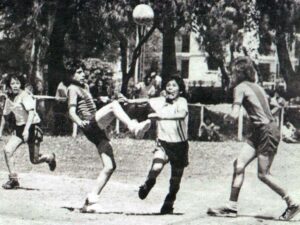
The first one was in 1930 in the inaugural World Cup in Uruguay, with the hosts beating Argentina in the final by 4-2. Guillermo Stabile, aged 25 at the time, was the topscorer of the tournament and one of the country’s first soccer heroes. Stabile was also born in Buenos Aires like Maradona, and grew up in Parque Patricios. He started playing soccer for a district team called ”Sportivo Metán” in the vast Patricios Park. That was where he sharpened his soccer skills before joining Huracan in 1920 at the age of 15.
Cristiano Ronaldo’s long and difficult road to stardom
He was teased by his Manchester United’s teammates about his slim physique in his early years at Old Trafford. Bullied by his schoolmates for his strong Madeira accent while at school in Lisboa. And he was always the youngest and smallest kid in the neighborhood team. Any idea where Cristiano Ronaldo’s massive ego and self-belief stems from?
1991, Santo Antonio, Futsal, Madeira. Cristiano was just 6 years old and all he wanted was to play in one of the neighborhood’s teams called ”Rua Quinta Falcao”. This was Ronaldo’s first ever team. And he managed to play, with the other boys who founded the team being 9 years old. Not only that. Their main rivals ”Rua Lombino” consisted of players who were even older, 11 or 12 years old. But, this is what Ronald was always aiming for: to play against the best, become the best. In 1992 he joined his first club, Andorinha, but he continued playing street soccer until he left Madeira in 1997 to join Sporting’s academy in Lisbon.
Giuseppe Meazza’s first steps
Meazza was born in Milan, in 1910. He started playing street soccer barefoot with a ball made of rugs at the age of six. It was during the World War I. Meazza and his friends founded a team called ”Costanza” as most of the boys lived on the Costanza Arconati Street. His talent was undisputed and he soon became the founder and the leader of a new team called ”Campionesi”, a name inspired by the street his family lived on, the Maestri Campionesi Street.
In 1922 he joined his first club Gloria FC and a few years later he signed for Ambrosiana-Inter after the club he supported, AC Milan, had rejected him. Giuseppe Meazza played for Italy’s ”Big Three” (Inter, Milan, Juventus) and guided the “Azzuri” to two World Cup wins (1934, 1938) and two Central European Cups (1930, 1935). On 3 May 1980, the San Siro stadium was named in his honour.
Year 2021: What ever happened to street soccer?
Starting a career on the concrete pitch was the only way some years ago. The professionalisation and commercialisation of the sport in recent years changed its culture and authenticity. Elite clubs invest huge amounts of money in a bid to produce and train players from an extremely young age. On most occasions academies of even small local clubs require a registration fee to keep up with their costs. This means that they hardly reject any players.
And on top of that it is the technology. It has taken the kids from the traditional street ball games to a domestic environment in front of a screen. Playing a video game instead of an actual soccer game. The new, “virtual” soccer reality.
[contact-form][contact-field label=”Name” type=”name” required=”true” /][contact-field label=”Email” type=”email” required=”true” /][contact-field label=”Website” type=”url” /][contact-field label=”Message” type=”textarea” /][/contact-form]




